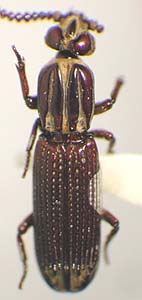Omoglymmiina
Ross T. BellIntroduction
Omoglymmiina is the largest subtribe of Rhysodini and the most diverse at the generic level. All species have complete elytral striation, and almost all have hind wings and large eyes of the usual rhysodine form. The group is nearly cosmopolitan but absent from New Zealand and Madagascar. It is most diverse and species rich in the islands of the southwest Pacific, especially New Guinea, and in the Oriental Region. There are seven genera and more than 150 species.
A key to the genera of Omoglymmiina is available here.
Characteristics
The median lobe of the head is short, and the temporal lobes usually have distinct medial angles and come closest to one another posterior to the apex of the median lobe. The frontal grooves are deep and complete except in Omoglymmius subgenus Navitia, in which they are shallow. The minor setae form rings on the outer segments of the antenna.


Omoglymmius (Omoglymmius s. str.) germari.
(A) Dorsal aspect of head, pronotum, and elytra.
(B) Antennal segments IX-XI.
Modified from Bell and Bell (1978). Copyright © 1978 Ross T. Bell and Joyce R. Bell.
The elytral striation is complete, and the marginal stria are seventh from the suture. The apical striole is usually distinct. The middle and hind tibiae have either one or two spurs.
Relationships of Omoglymmiina to Other Rhysodines
The apical rings of minor setae suggest a relationship to Rhysodina, Dhysorina, and Medisorina. The form of the temporal and median lobes approach Clinidiina, but this is likely attributable to symplesiomorphy.
References
Bell, R. T. 1975. Omoglymmius Ganglbauer, a separate genus (Coleoptera: Carabidae or Rhysodidae). The Coleopterists Bulletin 29(4):351-352.
Bell, R. T. and J. R. Bell. 1978. Rhysodini of the World part I. A new classification of the tribe, and a synopsis of Omoglymmius subgenus Nitiglymmius, new subgenus (Coleoptera: Carabidae or Rhysodidae). Quaestiones Entomologicae 14: 43-88.
Bell, R. T. and J. R. Bell. 1979. Rhysodini of the World part II. Revisions of the smaller genera (Coleoptera: Carabidae or Rhysodidae). Quaestiones Entomologicae 15: 377-446.
Bell, R. T. and J. R. Bell. 1982. Rhysodini of the World Part III. Revision of Omoglymmius Ganglbauer (Coleoptera: Carabidae or Rhysodidae) and substitutions for preoccupied generic names. Quaestiones Entomologicae 18: 127-259.
Bell, R. T. and J. R. Bell. 1987. Rhysodine beetles on the Geneva collection: a new species of Yamatosa, and a major range extension for Omoglymmius sakuraii Nakane (Coleoptera: Carabidae or Rhysodidae). Revue suisse Zool. 94(4):683-686.
Bell, R. T. and J. R. Bell. 1989. Rhysodine beetles on the Geneva collection II: new species of Yamatosa and Omoglymmius, descriptions of undescribed sexes in other species, and some major range extensions (Coleoptera: Carabidae or Rhysodidae). Revue suisse Zool. 96(3):637-642.
Bell, R. T. and J. R. Bell. 1993. Rhysodine beetles (Insecta: Coleoptera: Carabidae or Rhysodidae): New species, new data, and revised keys to Omoglymmius (Subgenera Omoglymmius and Pyxiglimmius). Annals of Carnegie Museum 62(2): 165-185.
Beutel, R. G. 1990. Metathoracic features of Omoglymmius hamatus and their significance for classification of Rhysodini (Coleoptera: Adephaga). Entomologia Generalis 15(3): 185-201.
Beutel, R. G. 1992. Larval head structures of Omoglymmius hamatus and their implications for the relationships of Rhysodidae (Coleoptera: Adephaga). Entomologica Scandinavica 23(2): 169-184.
Title Illustrations

| Scientific Name | Plesioglymmius (P.) silus |
|---|---|
| Location | Philippines: Mindanao: Zamboanga, Katasalan |
| Specimen Condition | Dead Specimen |
| Collection | CAS |
| Type | paratype |
| Image Use |
 This media file is licensed under the Creative Commons Attribution License - Version 3.0. This media file is licensed under the Creative Commons Attribution License - Version 3.0.
|
| Copyright |
© 2000 David R. Maddison

|
| Scientific Name | Arrowina anguliceps |
|---|---|
| Location | South India: Dodabetta Peak |
| Specimen Condition | Dead Specimen |
| Identified By | R. T. Bell |
| Collection | CAS |
| Image Use |
 This media file is licensed under the Creative Commons Attribution License - Version 3.0. This media file is licensed under the Creative Commons Attribution License - Version 3.0.
|
| Copyright |
© 2000 David R. Maddison

|
| Scientific Name | Omoglymmius hamatus |
|---|---|
| Location | California, U.S.A. |
| Specimen Condition | Live Specimen |
| Image Use |
 This media file is licensed under the Creative Commons Attribution License - Version 3.0. This media file is licensed under the Creative Commons Attribution License - Version 3.0.
|
| Copyright |
© 2000 David R. Maddison

|
About This Page
Ross T. Bell

University of Vermont, Burlington, Vermont, USA
Page copyright © 1999 Ross T. Bell
All Rights Reserved.
- First online 14 December 1999
Citing this page:
Bell, Ross T. 1999. Omoglymmiina. Version 14 December 1999. http://tolweb.org/Omoglymmiina/1797/1999.12.14 in The Tree of Life Web Project, http://tolweb.org/













 Go to quick links
Go to quick search
Go to navigation for this section of the ToL site
Go to detailed links for the ToL site
Go to quick links
Go to quick search
Go to navigation for this section of the ToL site
Go to detailed links for the ToL site